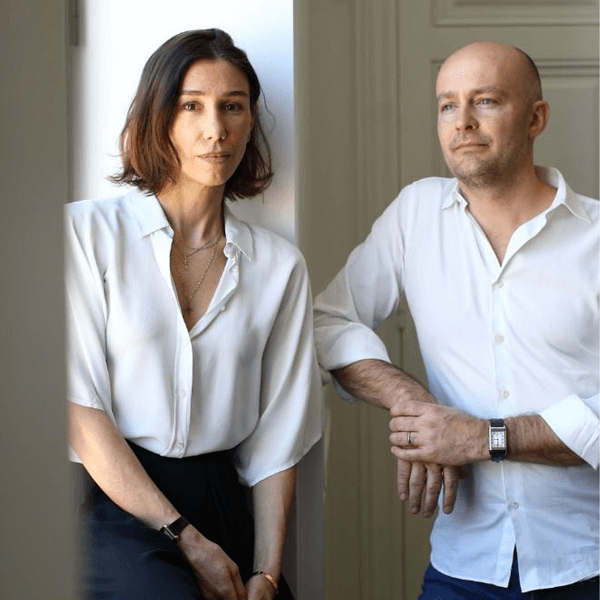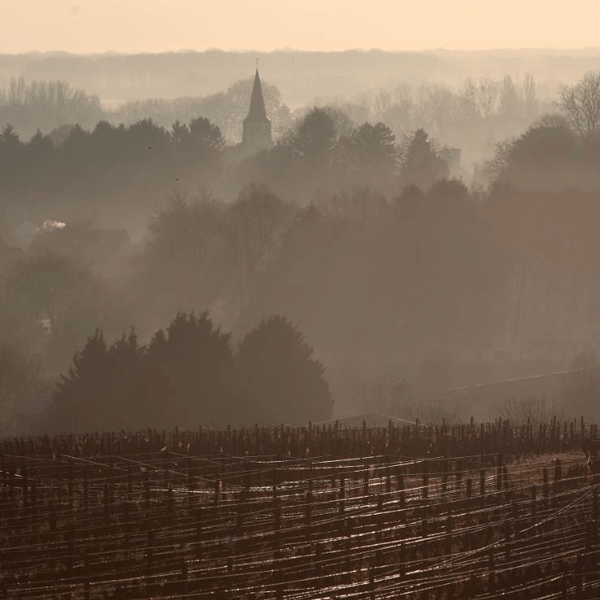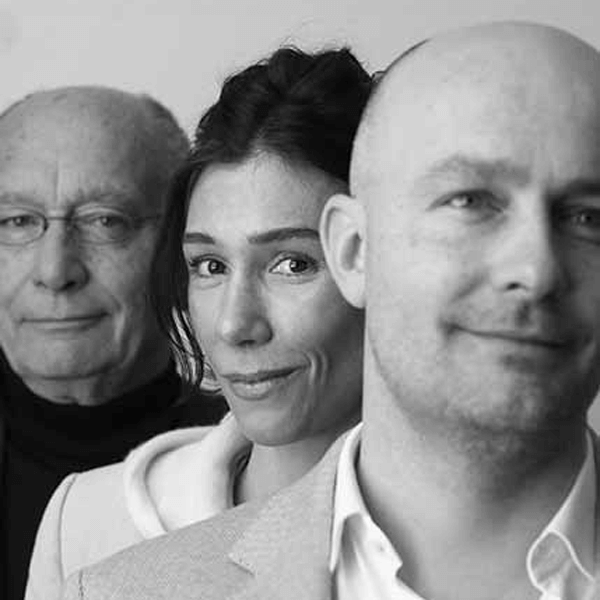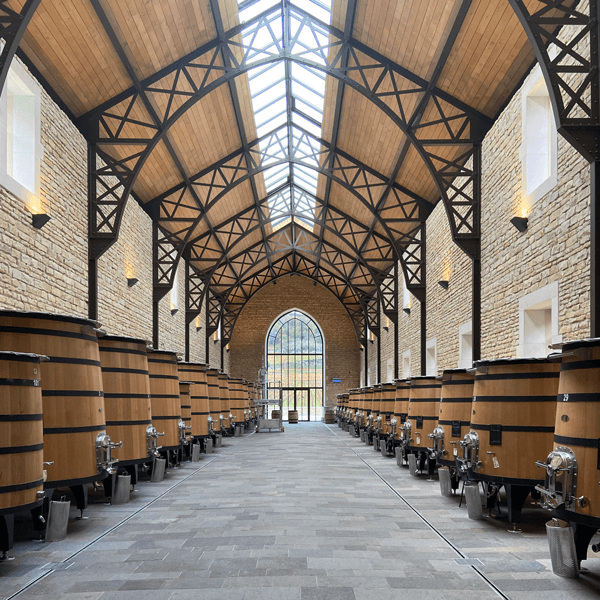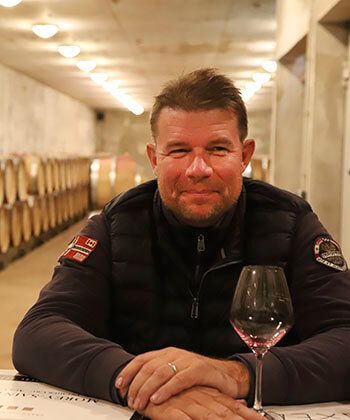Red Bigger Bottles
Please note that some of the web pages may take a few moments to load.

P & M Jacqueson
The domaine was founded in 1946 by Henri Jacqueson and passed to his son Paul. Marie joined her father in 2006 and since 2015 she and her brother Pierre run the estate, now known simply as P&M Jacqueson. The domaine consists of 18 hectares of vines, mostly in Rully, but also 5 in Mercurey and some in Bouzeron. The team also tend vines owned by their neighbours and make some beautiful wines from other peoples' fruit that they themselves have worked all year.
Traditional methods meticulously applied inspire everything they do: the grapes are harvested by hand and vinified in classical fashion, before an élevage in barrel (up to 25% new wood for the reds, just 20% for the 1er Cru Whites). The domaine has become adept at a sophisticated use of barrels, the élevage here is key to the quality they consistently achieve.

2023 MERCUREY 1er Cru Les Veleys P & M Jacqueson
Old vines here - some pre-war vines. Family bought it in 2013 - but do not know exact dates. Bought this from our friends, the Raquillet family. Faces east so, less sunny than Naugues. Smells moreOld vines here - some pre-war vines. Family bought it in 2013 - but do not know exact dates. Bought this from our friends, the Raquillet family. Faces east so, less sunny than Naugues. Smells more pretty - more red berries, elder and redcurrants - floral too with violets. Firmer palate and darker line than on the nose. Good grip. More serious. Lively. Intense and more concentrated, because the old vines.L&S (Nov 2024)
In Bond

Domaine Rémi Jobard
Rémi has been making small qualitative changes ever since he took over here. The entire vineyard is cordon-pruned, so yields are naturally limited. There has been no use of fertiliser since 1994, and the vineyard is grassed-over to encourage the vine roots to go deep. The domaine has been certified organic from 2008. He says that the two most important things are the absence of weedkiller (and thus the necessity to plough, which cuts any surface roots and makes the vine go deeper) and not adding any fertiliser which again makes the roots go deeper to find nutrients.Rémi has two vast presses, to enable him to press very slowly over six hours, and this has resulted in a big jump in finesse. The élevage now lasts nearly fifteen months, so as to allow the wines to develop slowly and to avoid fining. As a result these are wines which take a moment to show, but which reward the patient with complexity and great depth of flavour.
Rémi made a move from traditional barrels to foudres made of a mix of French, Austrian and Slavonian oak, constructed by Austrian cooper Stockinger, and having added a new one (or two) each year, there's barely a normal barrel left. He likes the way the wines develop in these large volumes, in which the 'oaking' effect is minimised.
We are again very excited about Rémi's two red wines this year, both of which are excellent.

Domaine Nicolas Rossignol
Nico is well settled into his bespoke build 'cellar' (it's all above ground). Admittedly it's in a ZI (Zone Industrielle) on the outskirts of Beaune, which is not ideal for the 'folklore' aspect, but it is a perfect tool for the job, and does have a good view of all 'his' bits of the Côte - from a sort of eyrie on the roof. He is convinced that his wines have gained in finesse since the move.
Nico is working with Bruno Lorenzon, who is a cooper as well as a vigneron, and using the lightest imaginable toasts - so much so that the barrel staves are very fragile, having not been steamed enough to bend the wood without extreme tension. Nico says that while the fashion is to use less and less new wood, he is using more, but while toasted barrels used to bring a welcome sucrosity to the wines in the past, it's not needed nowadays, as the wines have quite enough, so the wood is performing a different role, bringing finesse and lengthening the wines. It's a similar conversation we've had with Thibault Liger-Belair and his carefully chosen trees and 'white toasts'.
Nico is keen to let us know in advance that he regards this very much as primeur pricing, and says that once on the 'deliverable' price list will be 30-40% more expensive, so there is a real incentive to get stuck in early.

Domaine Comte Armand
A domaine totalling nine hectares, of which the most important part is a magnificent five hectare monopole of the Pommard Premier Cru Clos des Epeneaux, which was put together by Nicolas Marey in the eighteenth and nineteenth centuries (along with the DRC Romanée Saint Vivant 'Marey-Monge'). These vineyards were all sold, except for the Clos (it now been enclosed by a wall), which came to Jean-François Armand as a dowry when he married Nicolas' daughter in 1826. The Volnay vineyards were added in 1994, followed by parcels in Auxey Duresses.
The current Comte Armand is a lawyer living in Paris, but very supportive of the régisseurs who have looked after this domaine for the thirty years or so that L&S have been buying here. The 1980 vintage, made by one of the many Rossignols of Volnay who was in charge at the time, was for us a great introduction to the possibilities of the great Clos des Epeneaux vineyard. Then came the era of Pascal Marchand, a young Quebecois who came to do a harvest with Domaine Bruno Clair and just never left. He began a period of radical restructuring and the introduction of organic and then biodynamic farming, while making very dark, dense and long-lived wines. Benjamin Leroux, hugely respected amongst growers who approach things from an organic or biodynamic point of view, then took over, and refined this approach and changed the way the parcels of vines are divided up for harvesting, paying less attention to just the age of the vines, and more to the underlying soil types. Claude Bourguignon was employed to provide a full geological survey of the Clos as the basis for this. Under Benjamin the wines of the Clos gained in finesse and precision, while still having the depth and richness expected of a great Pommard.
Both Pascal and Benjamin were keen to expand beyond the confines of the Clos, and the Domaine also has vines in Volnay, and, a particular enthusiasm of both Pascal and Benjamin, in Auxey Duresses, where they are convinced of the great potential of some of this village's undervalued and neglected terroirs. Paul Zinetti, who had worked with Ben for four years, took over in 2014.
The vineyard is cultivated organically (ECOCERT certified) and biodynamically. The grapes are entirely de-stemmed, but left intact, for a five to eight-day cold maceration before the fermentation, which lasts five to ten days, and then the wine remains in the fermenters for between three and fifteen days, depending on the vintage. In most years, the total time with skin contact will be around four weeks, which is longer than most. The wines will then be aged in barrel for between eighteen and twenty-four months, with new wood limited to 30% for the wine from the old vines of the Clos, down to none at all for the village wines.
Paul said from the outset that he wanted to make a less tannic wine in the Clos, and one which is more about aromatic length. In this he is continuing the route that Ben was following, but perhaps taking it even further.

Domaine de Courcel
One of the great domaines of Pommard, with a 400 year history in the same family. The domaine produces a small amount of Bourgogne Chardonnay, a completely over-performing Bourgogne Rouge, a village Pommard (Vaumuriens, 1.44 ha), but the biggest part of the domaine consists of four great Premier Cru expressions of the terroir of Pommard, Fremiers (0.79 ha), Croix Noires (0.58 ha), Grand Clos des Epenots (4.89 ha) and Rugiens (1.07 ha). These represent a very different style to the Clos des Épeneaux of Comte Armand, for example. Yves Confuron, the régisseur, describes the difference between the two top wines by saying that the Grand Clos is 'terreux' while the Rugiens is 'aérien'.
The aim is to limit yields to around 25hl/ha, to attain optimum ripeness. The vines are ploughed, and pruned carefully to suit each one, then de-budded in spring and green-harvested in August to keep the fruit load balanced. Following Yves' usual practice the harvest is late and the vatting is long - usually around a month, with a cold maceration leading into a cool fermentation, and a long post-fermentation soak under the protection of the carbon dioxide given off by the fermentation. The wines are developed in barrel over 21 to 23 months, with a third of the barrels being replaced each year. After racking they are bottled without fining or filtration.
The domaine produces wines with astonishing depth and density that still retain the freshness, just like Yves' own wines at Domaine Confuron-Cotetidot. They are classic vins de garde and patience is advised - and will be amply rewarded.

Domaine Thierry Mortet
The domaine dates back to 1992, when Domaine Charles Mortet was split between Thierry and his brother Denis, and Thierry set up on his own with just 4 hectares of vines. Today he has 7.3 ha, of which 6 are red and 1.3 white. Only 4.36 hectares are Gevrey or Chambolle, the rest being a small parcel of Marsannay Blanc and regionals - Bourgogne Rouge and Blanc, Aligoté and Passetoutgrain.
Thierry continues to be praised in the French press without ever quite seeming to crack the influential American journalists. It may be simply because he is a bit short of fancy appellations - one little cuvée of Grand Cru would no doubt do his reputation a lot of good - but might also put his prices up, and these remain very modest.In the vineyard, Thierry has been certified organic since 2007, but really this was just an official stamp on what had been the practices of the domaine since the beginning, and he is working towards biodynamic certification. In the cellar, the grapes are entirely de-stemmed, and given four or five days of cold maceration are followed by the fermentation, with just a touch of cooling to keep the temperature around 31-33C (below 35, at least), and two pigeages a day. The total time in vat can be as little as 17 days. The wines then go into barrel, all second use or older for the Bourgogne, with 30% new wood on the Gevrey, and 50% on the Clos Prieur, for a period of around sixteen months.
Thierry's wines are fine and precise, tangy and long, never massive, but not insubstantial all the same. The surprise this year was to find Thierry joined by his daughter Lise who has done her vinicultural training and is now working at the domaine.

Domaine Stéphane Magnien
Stéphane's is a small domaine, a mere 4.5 hectares, with one full hectare of that in regional wine - Passetoutgrains and Bourgogne - but it is blessed with two Grands Crus and also a long history of not messing with nature. No pesticides have ever been used on this land, and the plants are nearly all the old 'Pinot tordu' - twisted Pinot with its gnarly stems which are less vigorous than the modern clones and said by many to make wines with more finesse.
Stéphane chaptalizes only to extend fermentations - these are wines which his father Jean-Paul used to describe as 'sage en alcool' - from 12 to 13% - the old vines do not make much alcohol. Wood use is also discreet, even though Stéphane has increased the proportion, he does not exceed 50% new wood on the Grands Crus, 25% on the Premiers Crus and on the village appellations, 15% new wood for one year only, then all into older barrels.
Stéphane says that he aims to make wines with more richness than his father's, 'but not black angular wines which have less relief. Wines which leave your mouth clean and clear, refreshed and revived and, above all, wanting another glass'. He destems 100%, gives the grapes a six-day maceration, then a classical fermentation with just two pigeages, and a little remontage (pumping over) at the end.

Domaine Faiveley
The Faiveley family are the largest vineyard owners in Burgundy, owning around 120ha, spread across the Côte de Nuits, Beaune and Chalonnaise and encompassing everything from generic Bourgogne up to the grandest of Grand Crus. Their own holdings supply the grapes for 5 out of every 6 bottles made by Faiveley, the balance being bought in from carefully selected contract growers.
Faiveley has been more and more impressive in recent years, and the combination of winemaker Jérôme Flous and an entirely new winery are taking them onwards and upwards year after year.

Domaine Joseph Drouhin
Joseph Drouhin, founded in 1880 and still family owned, are one of the most well-respected names in Burgundy, especially through their flagship wine, the iconic Clos des Mouches.
A huge part of the Drouhin production comes from their own domaine fruit (78 hectares), and much of the rest comes from contracts such as that with the Marquis de Laguiche, who shook hands with the grandfather of the current generation, agreeing to let him manage his vineyards which included an important part of Le Montrachet; this collaboration endures. Today, the fourth generation is at the helm
Small refinements continue to be made here. The presses have been changed - a reversion to basket pressing for the reds, and for whites the presses are open - along with a number of other growers they are following the trend to think that slight oxidation of the juice before fermentation is not a problem and may add complexity as well as avoiding later problems of premature oxidation in bottle.
For the reds there has been the introduction of selective whole-bunch fermentation in the Côte de Nuits wines. The house style remains one that 'emphasises the natural elegance of great Burgundies' as they describe it. The domaine is all cultivated with an organic and biodynamic approach.

Domaine des Lambrays
The 'Clos' consists of 8.66 hectares of land enclosed by a wall in which there is the original milestone marking its founding in 1365, confirmed in the records of the Abbaye de Citeaux (those monks knew where to place a vineyard). The Clos owes much of its current fame to the nineteenth and twentieth century proprietors who reconstituted it after the fragmentation of ownership which followed the French revolution. Despite always having been considered a Grand Cru site, the Clos was in fact classified Premier Cru in the original 1936 appellations contrôlées. The Rodier family which owned it from the 1930s fought to regain its Grand cru status, with eventual success only in 1981, when it became the last of the thirty-three Grands Crus of Burgundy, although by then it had passed to the Saier family. Recently under the benign ownership of the Günther Freund and his family, who gave a very free hand to régisseur Thierry Brouin, who had been employed by their predecessor Rolland Pelletier de Chambure, the quality of the wines here has pushed up again. In 2014 it was bought by the LVMH group.
It has been all rather quick change here as Jacques Devauge has taken over here after a short interregnum under Boris Champy. The legacy of Thierry Brouin can still be felt, Jacques describing him as having been 'clairvoyant' in his approach to the domaine, which has set it up well to deal with challenges of warmer vintages. Jacques seems set to take this estate onward - 'every domaine has to challenge itself to do better', he says. In 2021 the domaine was in its third year of organic certification and second for biodynamics.
Since 2019 the vinifications have been by parcel, and the different cuvées are laid out in barrel in the cellar as they come from the hill, which is a fun visual aid to the tasting. We did not manage to visit this year but by all accounts Jacques is very happy in his new cathedral-like vat room used for the first time for the 2022 vintage, and the wines are better than ever.

Domaine J. Confuron Cotetidot
Vignerons since the seventeenth century, the Confuron family has always selected and propagated vines to ensure that their plant material produces the highest quality, and they even have a clone of Pinot named after them - 'Pinot Confuron'.
The domaine has several Grands Cru vineyards as well as two hectares of the great Vosne Romanée Premier Cru 'Les Suchots'. There are around 12 hectares in all. The vines have never seen chemical weedkillers, and are ploughed and managed organically.
The Confurons have always used whole-bunch fermentation, picking very late, which really is a necessity if the stems are to be properly ripe and not give green flavours to the wine. A bit like the Thévenets with their whites in the Maconnais, they pick so much later that they can seem to have different vintages to everyone else. Yves thinks that 2007 was their great vintage of the first decade of this millennium, and he'd probably be the only grower in the Cote de Nuits who would say that. Yves also makes the wines at Domaine de Courcel in Pommard, in the same way.

Domaine Christian Clerget
A domaine of 6 hectares, with 8 appellations, run by Christian, Isabelle and their daughter Justine Clerget from their house in the northern end of the little village of Vougeot, which is really in the commune of Chambolle. They have been organic (certified) since 2017, Justine having insisted on it when she joined them, but it sounds as though she was pushing at an open door, because Christian is entirely committed to this approach and clearly believes that good wine starts with the vines.
At harvest the grapes are picked into small cases for the short trip to the winery which really is right in the middle of their holdings. They adapt to the vintage conditions, so that they did 2 pigeages in total in 2019, whereas in 2017, they did one a day throughout the fermentation. In 2018 they did some whole bunch fermentation, but reverted to their normal complete destemming in 2019. At the end of the alcoholic fermentation Christian decants into tank, allows the wine to settle for ten days, then puts the wines into barrel where they stay without racking until bottling. They are using about 30% new wood on the villages and 40% on the Chambolle Charmes and the Échézeaux, and the wines stay in barrel for a long élevage of 18-20 months.

Domaine Lignier-Michelot
A domaine now of 13.5 hectares, some owned, some in fermage with a little bought in. An average of 290 barrels a year. 25% regionals, 50% Villages, 20% Premiers crus and 5% Grands Crus. Virgile Lignier worked at the domaine with his father Maurice from 1988, beginning to bottle some of the wine from 1992 (it had previously been sold to the négoce), taking over in 2000, which was the vintage when he first bottled all the domaine's production.
In the vineyard Virgile made significant changes, stopping the use of herbicides, and beginning to plough instead. Green harvesting to limits yields followed, along with greater attention to grape selection. The domaine works organically except in extremis, so it's lutte raisonnée.
The wines are made with the least intervention possible, with lots of whole bunches. little extraction (one or two pigeages but mostly he's into remontages, then aged in barrel with 15-20% new wood. They have a lovely combination of enough body and richness, combined with a lively clarity of expression. The old vines village cuvées are seriously good, and great value too. Going up the scale each site seems to speak very clearly of its source and there is a brightness and energy along with full, seamless fruit.

Thibault Liger-Belair Successeurs
The lack of the word 'domaine' in the name signals that this is a négociant wine from Thibault Liger-Belair. Thibault buys the grapes he picks having tended the vines with his own team, so that the wines are domaine wines in all but name.
Domaine Thibault Liger-Belair
The steady progression of this domaine has been fascinating to watch as Thibault gradually refines his approach to each parcel of vines. Viticulture is biodynamic (since 2005), yields low but not ludicrously low, everything is pragmatic, so that he should be doing just what is necessary and no more. He uses 40-50% new wood maximum, with wood chosen and aged by him, and barrels made with almost no toasting.
The wines are bright, pure, focused, aromatic and elegant without lacking anything in the way of stuffing. There is a range of wines produced from rented vines or from bought grapes, sold under the separate 'Thibault Liger-Belair Successeurs' label. To each parcel the team brings great experience and there is a coherence across the range, so that the whole enterprise can be regarded as one.

Domaine Georges Mugneret-Gibourg
Sisters Marie-Christine and Marie-Andrée have been firmly in control of this exceptional domaine since their mother Jacqueline retired in 2009. With one a pharmacist and the other an oenologist, the domaine was always going to be in safe hands as far as the wine-making was concerned. In 2017 Marie-Christine 's daughter Lucie joined the domaine, and in 2019 the sisters celebrated their 30th vintage - and Marion and Fanny, daughters of Marie-Andrée also joined the team.
These are top-flight Burgundies with that elusive balance of enough concentration allied with delicacy of expression and the capability of ageing well.
Since 2016 they have put a small amount of whole bunches in some of the cuvées, more as a way to have sufficient volume in the vats than because they like the effect.
THE DEMAND FOR THESE WINES FAR EXCEEDS SUPPLY AND THEY ARE ESSENTIALLY ALL ALLOCATED FROM YEAR TO YEAR






































